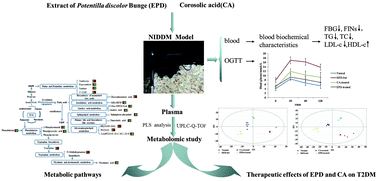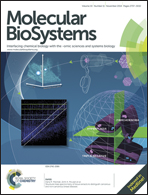Metabonomic analysis of the therapeutic effect of Potentilla discolor in the treatment of type 2 diabetes mellitus†
Abstract
Type 2 diabetes mellitus (T2DM) is increased worldwide in parallel with the obesity epidemic. Potentilla discolor is one of the most important crude materials in Traditional Chinese medicine (TCM) for therapy of hyperglycemia and hyperlipidemia. In this work, a plasma metabonomic approach based on the combination of UPLC-Q-TOF with multivariate data analysis was applied to investigate the therapeutic effects of the extract of P. discolor (EPD) and corosolic acid (CA), the main bioactive compounds of P. discolor. Male C57BL/6 mice were fed with high-fat diet (HFD-fed group) for 8 weeks and then treated with EPD (EPD-treated group) or CA (CA-treated group) for another 8 weeks. After the experimental period, samples of plasma were collected and analyzed by ultra-performance liquid chromatography/quadrupole time of flight mass spectrometry (UPLC-Q-TOF). The principal component analysis (PCA) and partial least squares discriminant analysis (PLS-DA) models were built to find biomarkers of T2DM and investigate the therapeutic effects of EPD and CA. 26 metabolites, which are distributed in several metabolic pathways, were identified as potential biomarkers of T2DM. It was found that EPD and CA could reverse the pathological process of T2DM through regulating the disturbed pathway of metabolism. The metabonomic results are beneficial not only for the evaluation of the therapeutic effect of TCM but also for the elucidation of the underlying molecular mechanism.


 Please wait while we load your content...
Please wait while we load your content...